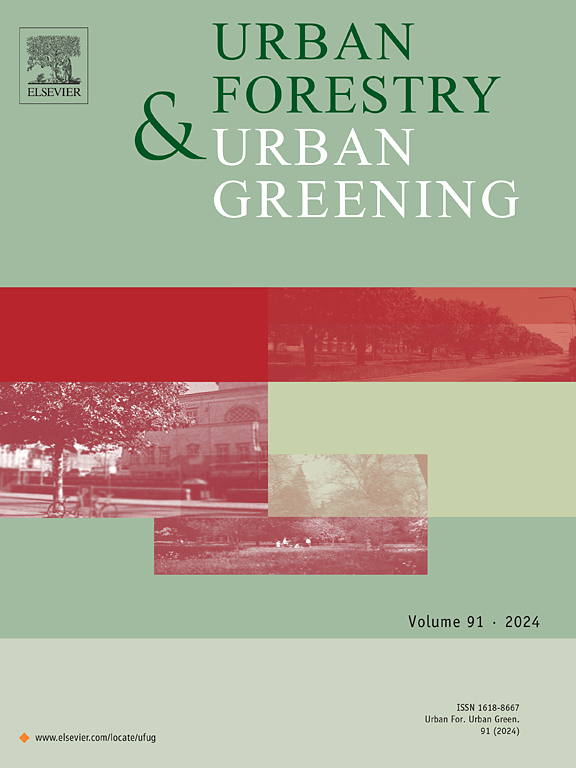Visitor motivations and design feature use for thermal comfort on hot days in Bochum City Park, Germany
IF 6
2区 环境科学与生态学
Q1 ENVIRONMENTAL STUDIES
引用次数: 0
Abstract
The rising incidence of extreme heat in urban areas poses challenges to urban living, affecting thermal comfort and public health. Public green spaces (PGS), such as parks, play a crucial role in mitigating heat and acting as 'cooling oases' that enhance visitors' thermal comfort and offer various other ecosystem services. Despite their importance, the specific role of thermal comfort in motivating individuals to visit PGS remains unclear. This study aims to explore the connection between thermal comfort and PGS visits on hot days, with a focus on visitor motivations and the park features that promote comfort. We conducted systematic observations involving quantitative counts of PGS visitors and rapid questionnaires on summer days of varying temperature ranges in Bochum City Park, Germany. Results indicated that the motivation to achieve thermal comfort by visiting the park significantly increased from ‘slightly warm’ to ‘warm’ days, especially among older visitors, and was independent of other motivations for visiting. Furthermore, results showed that the perceived temperature has a limited impact on the use of PGS features, with sun exposure emerging as a decisive factor. The findings can inform the planning and design of PGS, with the aim of creating desirable and thermally comfortable environments as cooling oases for urban residents.
德国波鸿城市公园热天舒适度的游客动机和设计特点使用情况
城市地区极端高温发生率的上升给城市生活带来了挑战,影响了热舒适度和公众健康。公园等公共绿地(PGS)在缓解炎热、充当 "凉爽绿洲"、提高游客热舒适度以及提供其他各种生态系统服务方面发挥着至关重要的作用。尽管其重要性不言而喻,但热舒适度在促使人们游览 PGS 方面的具体作用仍不明确。本研究旨在探讨热舒适度与游客在高温天游览私人保护区之间的联系,重点关注游客的游览动机和公园中能提高舒适度的特征。我们在德国波鸿城市公园进行了系统的观察,包括在不同温度范围的夏日对公园游客进行定量计数和快速问卷调查。结果表明,从 "微热 "天到 "温暖 "天,通过游览公园获得热舒适度的动机明显增加,尤其是在老年游客中,而且与其他游览动机无关。此外,结果表明,感知温度对使用 PGS 功能的影响有限,而阳光照射则是决定性因素。这些研究结果可以为 PGS 的规划和设计提供参考,从而为城市居民创造出理想的、热舒适的凉爽环境。
本文章由计算机程序翻译,如有差异,请以英文原文为准。
求助全文
约1分钟内获得全文
求助全文
来源期刊

Urban Forestry & Urban Greening
FORESTRY-
CiteScore
11.70
自引率
12.50%
发文量
289
审稿时长
70 days
期刊介绍:
Urban Forestry and Urban Greening is a refereed, international journal aimed at presenting high-quality research with urban and peri-urban woody and non-woody vegetation and its use, planning, design, establishment and management as its main topics. Urban Forestry and Urban Greening concentrates on all tree-dominated (as joint together in the urban forest) as well as other green resources in and around urban areas, such as woodlands, public and private urban parks and gardens, urban nature areas, street tree and square plantations, botanical gardens and cemeteries.
The journal welcomes basic and applied research papers, as well as review papers and short communications. Contributions should focus on one or more of the following aspects:
-Form and functions of urban forests and other vegetation, including aspects of urban ecology.
-Policy-making, planning and design related to urban forests and other vegetation.
-Selection and establishment of tree resources and other vegetation for urban environments.
-Management of urban forests and other vegetation.
Original contributions of a high academic standard are invited from a wide range of disciplines and fields, including forestry, biology, horticulture, arboriculture, landscape ecology, pathology, soil science, hydrology, landscape architecture, landscape planning, urban planning and design, economics, sociology, environmental psychology, public health, and education.
 求助内容:
求助内容: 应助结果提醒方式:
应助结果提醒方式:


